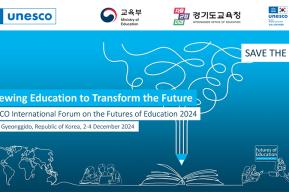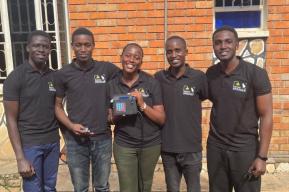There are an estimated 11 million people incarcerated worldwide. The right to education is denied to many of them. Imprisoned for 20 years, Wilfredo Laracuente was provided with the chance to learn – and turn his life around. His story underlines the importance of providing lifelong learning opportunities in prisons and detention centres, as advocated for by the UNESCO Institute for Lifelong Learning.
Wilfredo Laracuente ...
... was convicted of second-degree murder at the age of 26 and sentenced to 20 years to life.
The then young father of two was incarcerated in the maximum-security Sing Sing Correctional Facility in New York State, USA.
Left as a child by his biological father, Laracuente was determined to be a positive role model to his daughters and support their learning and development.
Nevertheless, there was a mismatch between his ambitions and his reality: as an inmate without a high school degree, Laracuente’s chances of accessing high-quality adult education were tenuous.
A second chance: The Hudson Link
Laracuente’s chance to enrol in continuing education at Sing Sing was made possible because of a series of events that took place in the mid-1990s.
An opportunity, disguised as a setback, arose in 1994, when Congress voted to cut grants to prison education programmes. In response, a partnership between prisoners, college educators, community leaders and dedicated volunteers was formed to find a solution.
Their collective efforts resulted in 1998 with the creation of the Hudson Link for Higher Education in Prison programme, which provides education, vocational skills and re-entry support to incarcerated men and women from all backgrounds.
Lifelong learning for all
Since its founding, Hudson Link for Higher Education in Prison has partnered with several colleges in New York State to coordinate and ensure increased access to education in prisons along with technical and vocational education and training and career-readiness skills.
Today, this non-profit organization operates in five correctional facilities with nine college partners.
The programme has reached over 1,200 inmates and awarded over 700 college degrees, impacting the lives of prisoners, their families and communities – a true testament to Hudson Link Founder Dr Anne Reissner’s belief that ‘education equals hope’.
Hope for the future
In 2001, Hudson Link began partnering with New York State-based research university Mercy College.
Since then, the college has provided Sing Sing inmates with the opportunity to pursue associate’s and bachelor’s degrees in behavioural science while incarcerated.
Taking advantage of this opportunity, Laracuente enrolled on the course in his last years in prison, graduating in 2021 with a bachelor’s degree in psychology. Education was transformative for Laracuente, providing him with hope for the future and to ‘think beyond prison walls’.
We start to see hope; we start to see opportunity, and then what higher education does, is it allows us to configurate ourselves into becoming the best possible version of ourselves, not only for our families, but also for our communities as well.
A path with challenges
However, the path towards higher education in prison was not without its challenges.
Not only did Laracuente face practical challenges – such as studying without an internet connection and in a noisy environment – but various social challenges, such as peer jealousy.
A lot of the challenges really stem from different areas. There are peers that frown upon you pursuing your higher education because higher education just isn’t for everybody, so a lot of times, you have to deal with having to shuck or get rid of a lot of different social groups and you have to become more mature and enter different social groups of other people who are centred around higher education because as the mantra goes, ‘You show me who your friends are and it shows you who you are.’
Prison education contributes to reducing violence
US Government statistics show that rates of violence for male inmates are more than 18 times higher than for males in the general population. For female inmates, the rates are more than 27 times higher.
Access to education in prisons is known to have a positive impact in this regard. A survey at a prison in Indiana, in the Midwestern United States, showed for example that incarcerated people who were enrolled in education programmes committed 75% fewer infractions than those who were not.
This study also noted that prison education worked as a unifying force, breaking down racial and ethnic barriers – barriers that often were the cause of ongoing tension and violence.
Source: WHO & Northwestern Prison Education Program
Higher education should be in every prison, medium or max. The maximum correctional facilities are the ones that need it the most because they breed a higher propensity of violence. Studies show – and I don’t really need data, I could just tell from being around prisons - that when prisons have a lot of programming and when prisoners have higher education, the propensity for violence goes down because the culture is perpetuated around rehabilitative services or habilitative services that the men can participate in.
Making lemonade out of lemons and paying it forward
Studying led Laracuente to greater levels of self-awareness and provided him with new contexts within which to understand his social circumstances and progression. These realizations made him more passionate about giving back to his community and, today, he is doing just that.
You start to see a lot of the things that you probably never thought about when you were younger. A lot of the things that we deal with in our communities as far as cognitive dissonance, or as far as just dealing with disenfranchisement or worried about arrested development. We never were able to understand what these concepts were; they were punchlines that were located in certain types of rap songs that we would hear, and when I finally learned what these concepts meant, it really meant something to me that I had to give back to my community and I had to make sure to make my education useful upon my release, and that’s something that I do every single day.
Since his release, Laracuente uses his educational and hands-on experiences to give back to society via his roles as programme coordinator of the Prison Education Project at the Center for Justice at Columbia University, in which he assists in teaching incarcerated students at Sing Sing prison. He is also a mentor at the CFJ Justice Ambassadors Youth Council, tutor at Columbia Business School, and advocate for the end of forced labour in New York State prisons.
I mentor a lot of youth now, from the ages of 14 to 18. I use my TedTalk as well, in order to let them know that, regardless of my circumstances, and I had a lot of lemons, I had to find the sugar to make lemonade. Higher education became that sugar and that fuel that gave me the ability to be released and be able to make lemonade and be an asset among our community.
Background
The right to education is at the heart of UNESCO's mission. Providing prisoners with access to quality education from the first day of their incarceration through to and beyond the day of their release is key in this context.
The UNESCO Institute for Lifelong Learning (UIL) works to improve existing education in prison policies and practices that are designed to support incarcerated people’s rehabilitation and reintegration into society.
As part of this work, UIL interviews lifelong learners like Wilfredo Laracuente to shed light on in-prison education programmes throughout different parts of the world.
Watch the entire interview here.
Learn more: Education in prisons, Books beyond bars.










